While Jose Mourinho was at the helm at Manchester United, Anthony Martial and Marcus Rashford were competing for positions in the starting XI. In the 2017/18 Premier League campaign, the two forwards only started 5 games together throughout the season.
Both the Englishman and his French teammate have always possessed similarities throughout their development; both predominantly being positioned on the left-wing but having intentions to play through the centre. However, their playstyles have always had clear differences, with Martial playing with more close control, and Rashford focusing on his pace and power.
However, in the past year, it has seemed as though both players have found their real identities in their play and positions; with Martial operating through the middle – almost as a false 9 – while Rashford has found his success through an inside-forward role on the left.
Since Ole Gunnar Solskjaer became the manager at United, the two forward men have been pivotal in his tactics and have almost always been a part of the same line-up when fit and they have found quite the partnership across the season; even though both players have had injuries at either end of the season so far.
This tactical analysis, which will be in the form of a scout report will be looking into the performances of both Rashford and Martial when operating together for Manchester United in the 2019/20 campaign. Throughout this analysis, we will see how the two players have been employed in Solskjaer’s system simultaneously, and why they have struck a great partnership for the Red Devils.
Individual skill sets
Before I delve into how the Manchester United men work together in the forward areas, I will take a look at their individual skill sets and show the individual threats each of them can pose.
Anthony Martial
Anthony Martial made his return to the centre this season, as well as getting his preferred number 9 shirt. The forward has garnered 15 goals and six assists in all competitions this season in 2526 minutes; averaging a goal contribution every 120 minutes.
It has been an impressive season for Martial; the Frenchman provides great link-up play with his midfield teammates and is often a great transitional tool for Manchester United. Martial has an impressive passing accuracy of 82.62%, while also playing an average of 5.49 forward passes per 90. The forward player will often use his dribbling or passing to progress the ball; he averages 1.54 and 2.17 progressive runs and passes respectively.
Martial is also a clinical finisher, a key factor for any lone striker. He possesses an impressive 20% conversion rate this season, as well as managing to get 49.24% of his shots, on target.
Marcus Rashford
Marcus Rashford has had the best campaign of his career so far. He has found his position as an inside forward on the left side and has been able to stick to it throughout the season. Rashford was on course for a brilliant season before injury struck in January. The Englishman had already managed 19 goals and five assists in 2364 minutes this campaign; with a goal contribution every 98.5 minutes.
Rashford is simply at best when dribbling at the defensive line, whether that is on the outside channel or cutting inside and either linking up or shooting at goal himself. Rashford averages 5.97 dribbles per 90, showing his consistent willingness to dribble. He also has scored six goals after a dribble in the last year in the Premier League.
The English international has been very good in the final third this season, as he often looks to come inside and shoot as said before. This is backed by his average of 3.14 shots per 90. Rashford also has improved in his passing this season, averaging 3.08 passes to the penalty area and 1.41 through passes per 90 minutes, helping him develop his link-up this season.
Interchangeability
A prominent and obvious benefit of having the duo starting together is the interchangeability in their attacks. According to Transfermarkt, Rashford has played 46.2% of his games at United as a striker and 42.7% as a left-winger. While Martial has played 37.5% as a striker and 52.8% as a left-winger.
The fact that both players are comfortable in either position means that they can often interchange throughout games. This suits Martial especially, who likes to drift out wide so that he can receive the ball to his feet.

Both Rashford’s and Martial’s heatmaps from this season support that they are willing to move across the front line. With Rashford having most of his action wide-left but also has much of it in more central areas too. While Martial has his action spread across the front line with the majority of it being central.
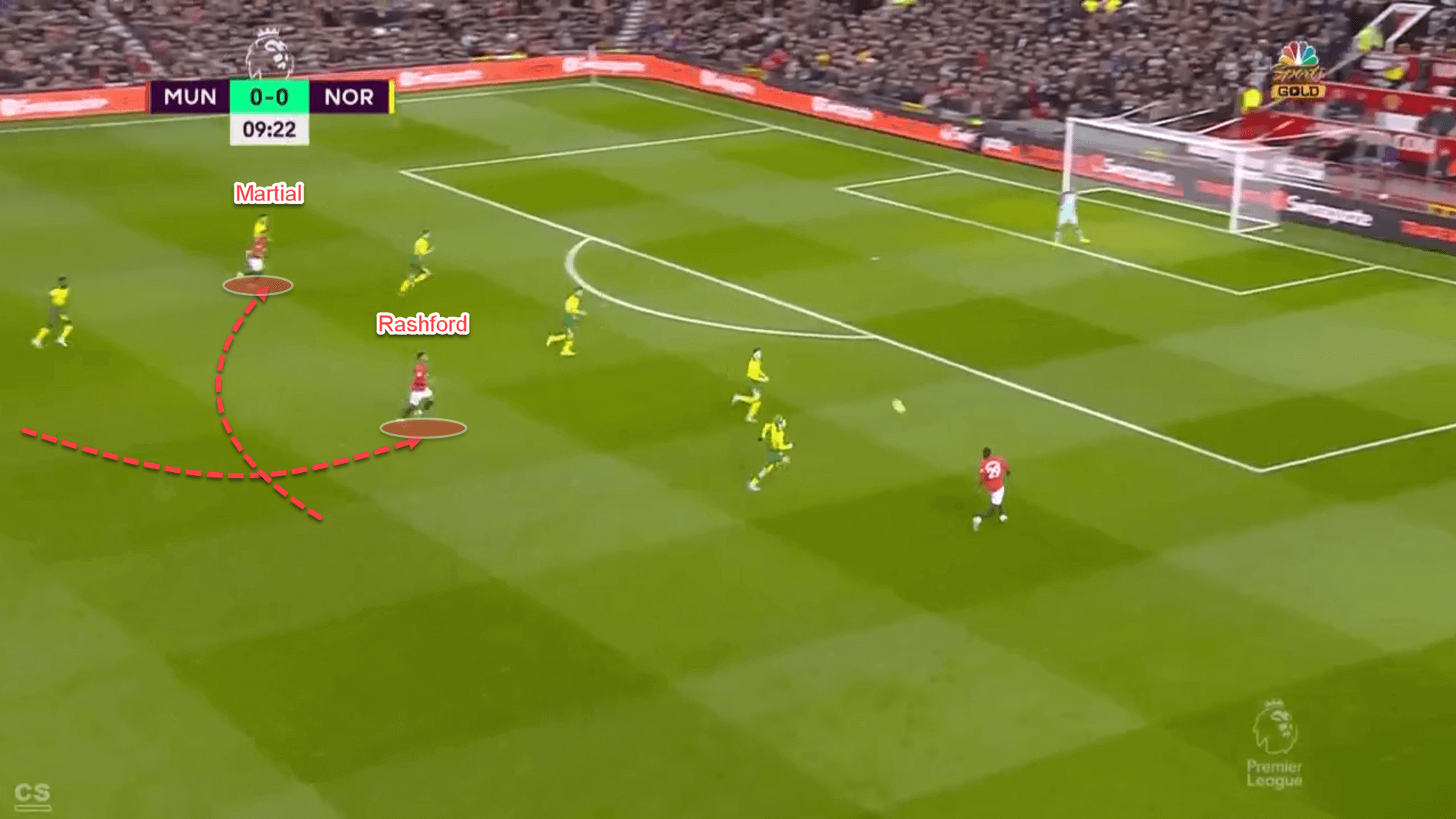
Shown above is a clear example of Martial and Rashford interchanging during the game. As Martial makes a run towards the left side, Rashford drifts centrally, this makes it more difficult for the players to be marked. Rashford receives the pass from Wan-Bissaka on the right and drives inside the area and attempts to cross. This is mainly possible because Rashford is not picked up by any opposition players as he has moved inside from the left.
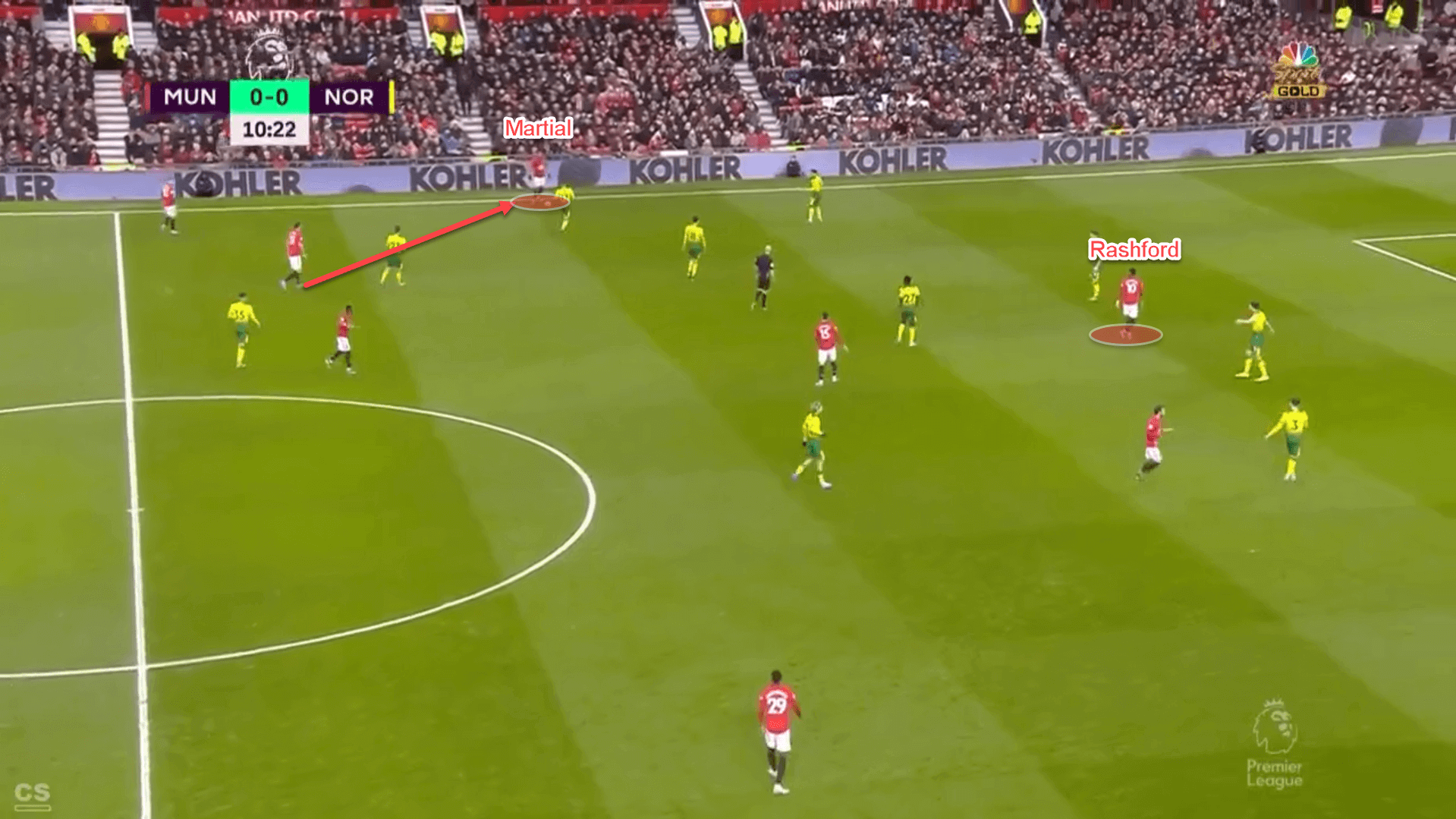
Again, the image above shows the positional switching that can occur when Martial and Rashford are playing together, with Martial moving all the way towards the touchline so that he can be involved with the build-up and potentially run at the full-back. During this, Rashford is positioned in between the two Norwich centre-backs. Although Martial is not able to create anything on the ball in this situation and instead passes back to Luke Shaw, it still shows the intentions of the players to interchange so that they are less predictable in attack.
Not only do they interchange positionally but the pair also interchange in their attacking actions. Martial enjoys dropping in and building the play and receiving the ball to his feet, while Rashford is more willing to run in behind the defensive line; they can also switch it up and Rashford can offer to be the progressor from deeper areas, while Martial makes those runs in behind the defensive line. Below are both player’s maps with their progressive passes, showing how they both can drop deeper and help with progression.
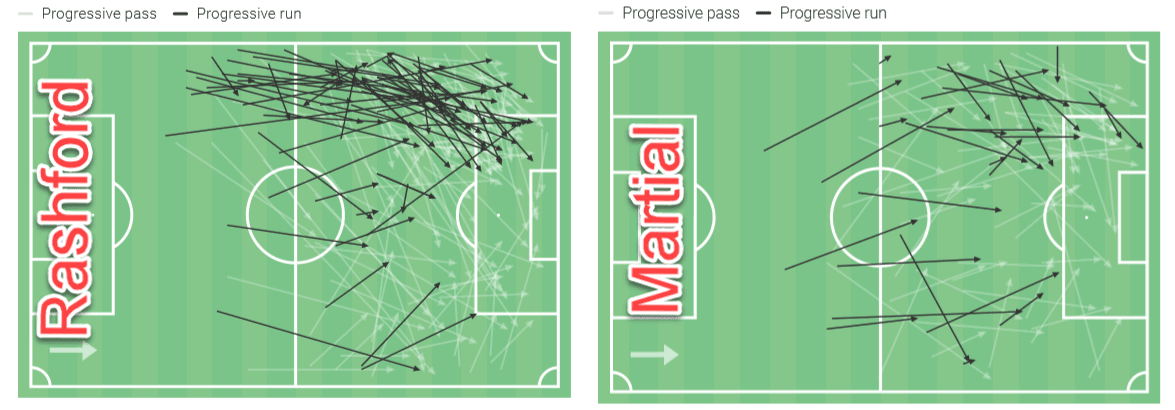
As you can see, Martial moves across the pitch and drops into deeper positions to progress the ball with his passing whereas Rashford shows that he will move into wider areas to pick up possession of the ball, so that he, himself, can progress the ball forward. It is also easier to progress the ball by passing from a wide position, with Rashford and Martial averaging 3.64 and 2.17 progressive passes per 90 respectively.
Although there is not a clear metric to determine the runs in behind a defensive line that a player makes, whenever one of Martial or Rashford drop deeper to attempt to progress the ball; the other will look to make a run in behind to either receive the ball or to stretch the defensive line of the opposition.
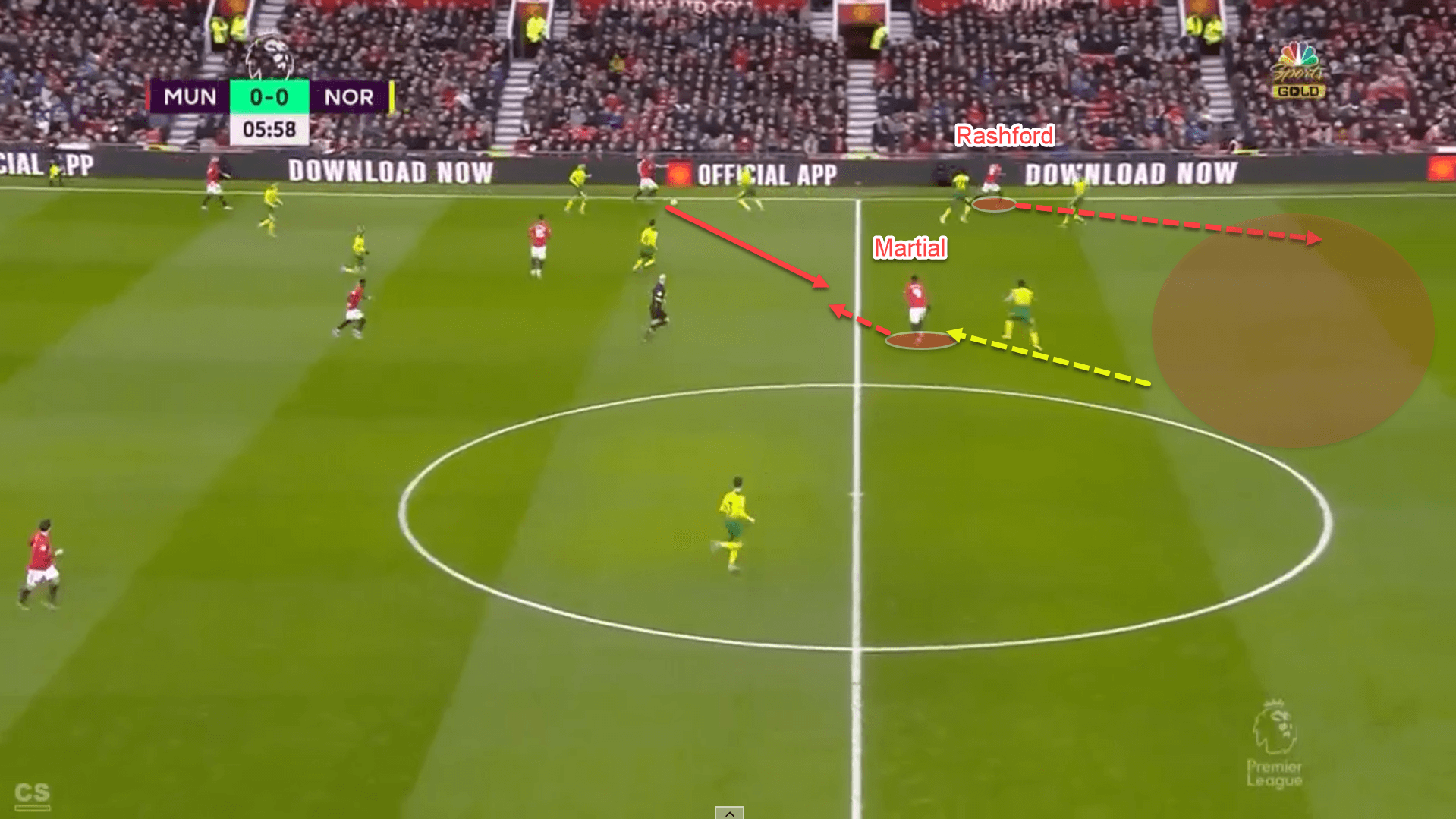
The image above shows Martial offering the ball to feet. This movement consequently brings the Norwich centre-back with him. This results in a space being opened behind the opposition left-back, where Rashford can run into without having a covering centre-back. If a pass is played behind the defence, Rashford would only have to win the footrace on the left and would be able to drive inside the box; this pass is not played though. Instead, it is played to Martial’s feet, where he is tackled. The image shows that the movements that the two players make often will complement each other.

The images above show a situation where Rashford is offering the pass into his feet, while Martial is making the run in behind the opposition defence. As you can see in the left image, Both Martial’s and Rashford’s movements drag opposition defenders into positions where they do not want to be. Martial’s movement in behind takes one Norwich centre-back behind the rest of his defensive line, while Rashford has dragged the other centre-back into a higher position; this results in the Norwich defensive line looking rather suspect as shown in the image on the right. The result of the movement of the two United forward players and the disorganised Norwich backline is the space in the wide areas for United, especially on the right, where Aaron Wan-Bissaka can ultimately receive the long pass in space in the opposition third.
The two players have a great understanding of each other and the movement that the other one makes. In order to ensure that they do not make the same movements, this understanding is crucial. The fact that Martial and Rashford have this is good for the whole side as the midfielders and defenders will have different options in the final third, rather than two attacking players making similar movements.
Link-up between the two
Another clear advantage of having both players in the same lineup is the fact that they can link-up together really well in the final third. In fact, even though the two players experienced periods of the season without the other due to injury, they are each other’s top shot assistants. Martial has assisted Rashford to shoot 10 times, while Rashford has assisted Martial to shoot eight times.
The two players like to be closely positioned on the pitch so that they can attempt to link-up, whether this is in the centre or towards the left can change. Below are examples which show that although one player is a winger and the other is a striker; they still operate in areas close to each other, almost like a front two would.
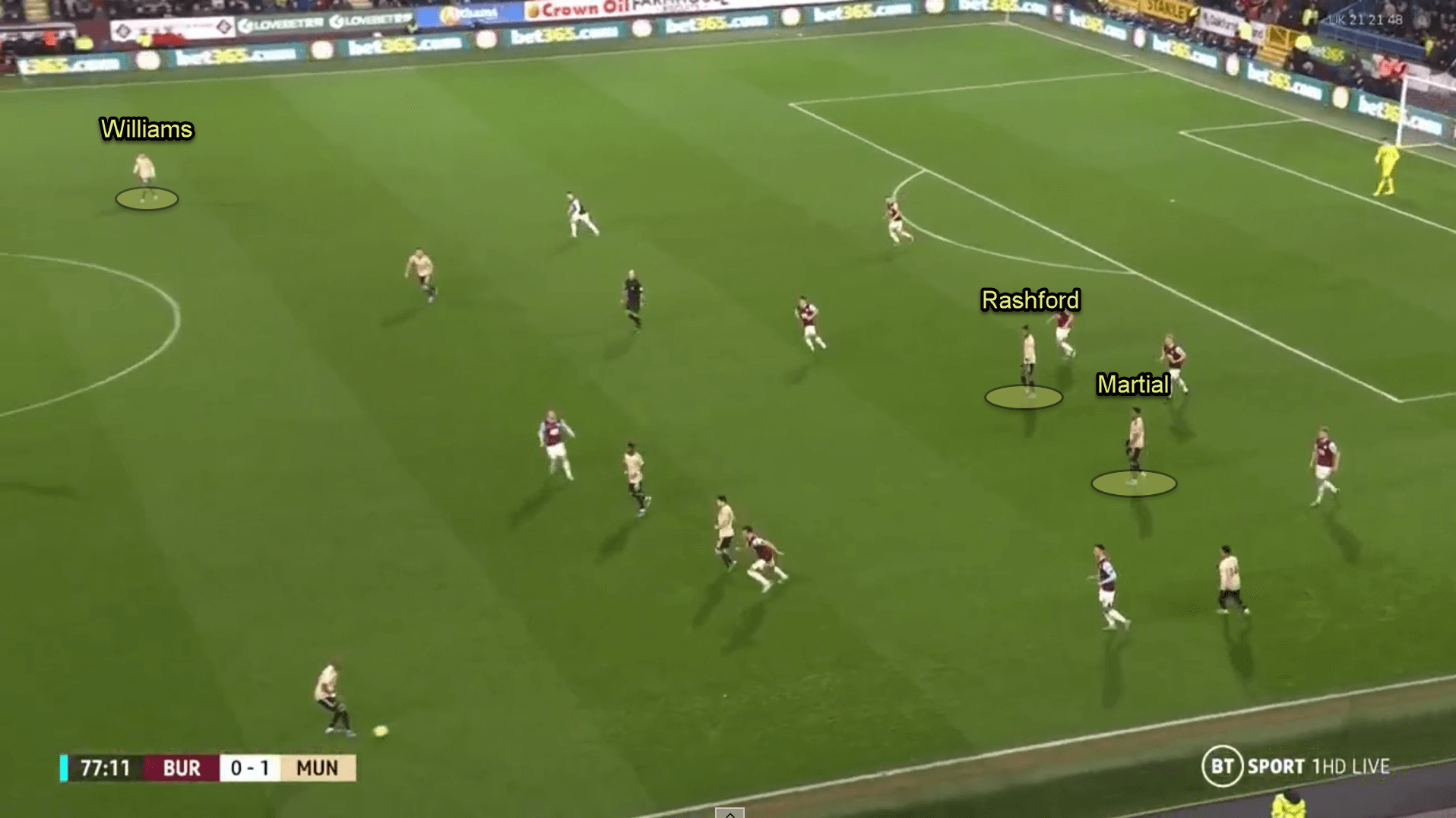
The image above shows the close positions in attack the two have, with Rashford in a central area, and the two making a front two. This is done so that they can make quick passes between one and other if the ball is played into one of them. However, when Rashford makes this central movement, the left-back of Man Utd needs to step into a higher position in order to occupy the left-wing. In the image above, Brandon Williams should be in a higher position to ensure there is an attacking threat from the left side.

The above image is an example of the close link-up play that the two have. Martial has the ball on the edge of the area and acknowledges the space between the Burnley right-back and centre-back. He plays a quick fire pass into Rashford’s feet and begins to move into the space between the Burnley backline. Rashford’s first time return pass finds Martial’s feet perfectly but the Burnley defender gets across to tackle well. The quick movement and passing from the United duo was impressive nonetheless.

Shown above is another clear example of the link-up play that Martial and Rashford are capable of. With Martial playing a through ball into Rashford, the Frenchman then runs into the space created on the left. Rashford expertly returns the pass to Martial with a backheel and Martial finishes past Tim Krul to score. They have a great understanding of each other’s movement and are both unselfish players when attacking together.
The duo clearly have a great connection in the final third and their link-up can only improve further in the future. This is exciting, especially if United can introduce a third man to this attacking threat in Jadon Sancho.
The movement to maximise each other’s output
As I have already explained, the two players understand each other’s game greatly. This is most notably shown in the movement which each player makes to help maximise the output of the other, they are both unselfish in this aspect.
Martial takes the lead in this department, particularly because of his intelligence when making runs off the ball. The striker will consistently look to create space for Rashford to make his trademark surging run infield; the Englishman averages 2.83 progressive runs per 90; showing how he enjoys progressing into the final third with the ball at his feet.

These images above are clear examples of how the intelligent movement of Martial can maximise the output of Rashford. With the ball at his feet, Rashford is looking to run into the space infield; however, the centre-back could potentially step out and engage Rashford if he does this but Martial’s smart run drags the Brighton centre-back into a wider position. This opens up space for Rashford to drive into and the play results in a dangerous shot from the Englishman being saved by the Brighton goalkeeper.
Martial’s movement is the underlying factor in how Rashford managed to find the inside lane with such ease. This movement can also allow Rashford the space to shoot, which he does so often. The wide man averages 3.14 shots per 90; with 46.82% of his shots in the last calendar year being from outside of the area. In order to shoot well from distance, he needs space, which Martial helps him with.
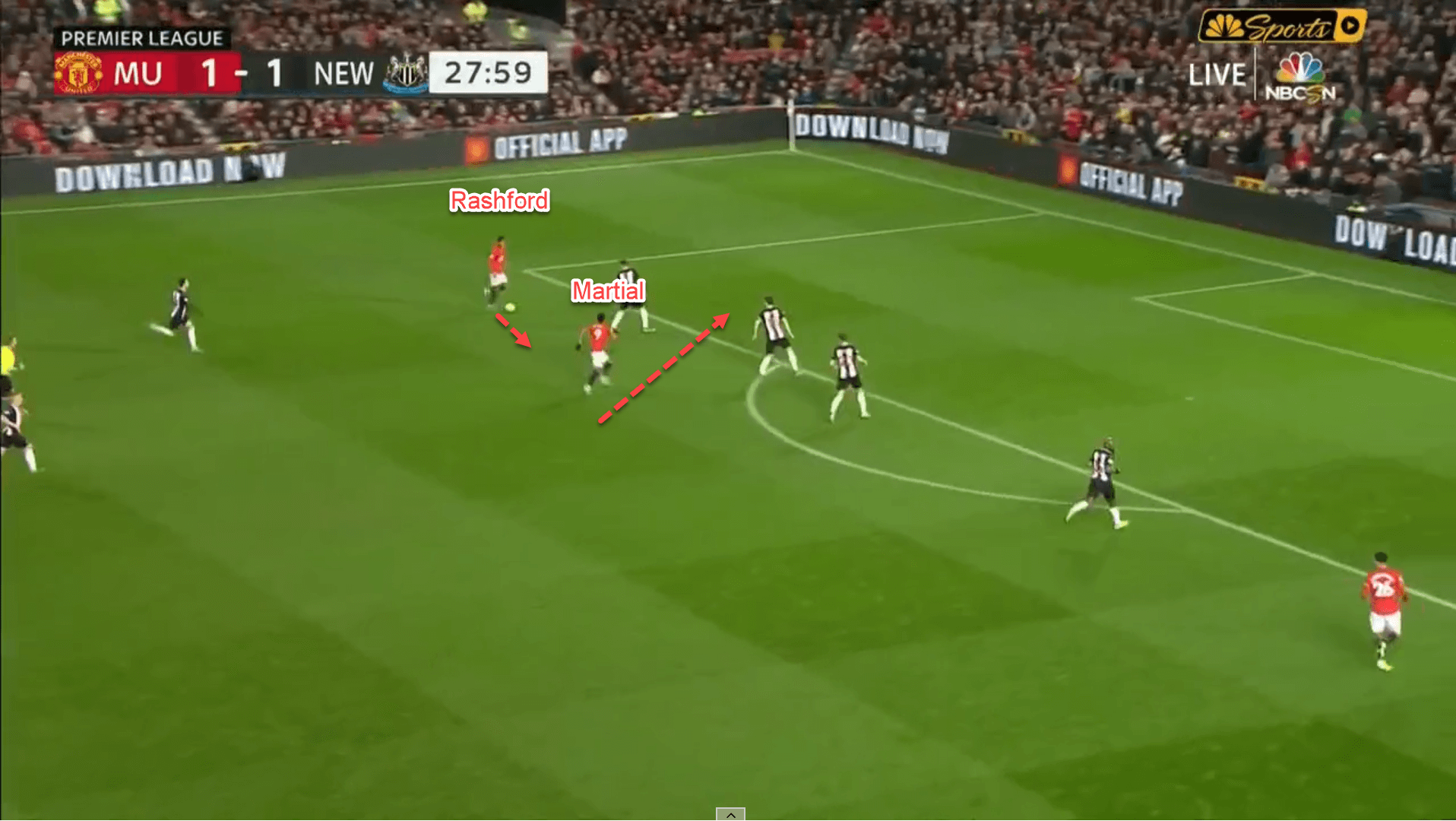
The above image shows this, with Martial initially passing Rashford the ball. Rashford is then looking to cut inside and unleash a shot, but he needs space and the Newcastle defenders are ready to come out and block his shot. Martial’s run beyond the defence pins the defenders back as if they now commit forward, Rashford can slide Martial in behind the defensive line. This leads to Rashford having the space needed to take the ball onto his right foot and shoot. The space had been created by Martial’s intelligent run.
Rashford can also help Martial with his movement. It is clear that the Frenchman likes to operate between the lines and enjoys dropping into deeper areas. Rashford’s direct runs beyond the defence can often pin them back so that Martial can get the ball in between the lines of the opposition easier.
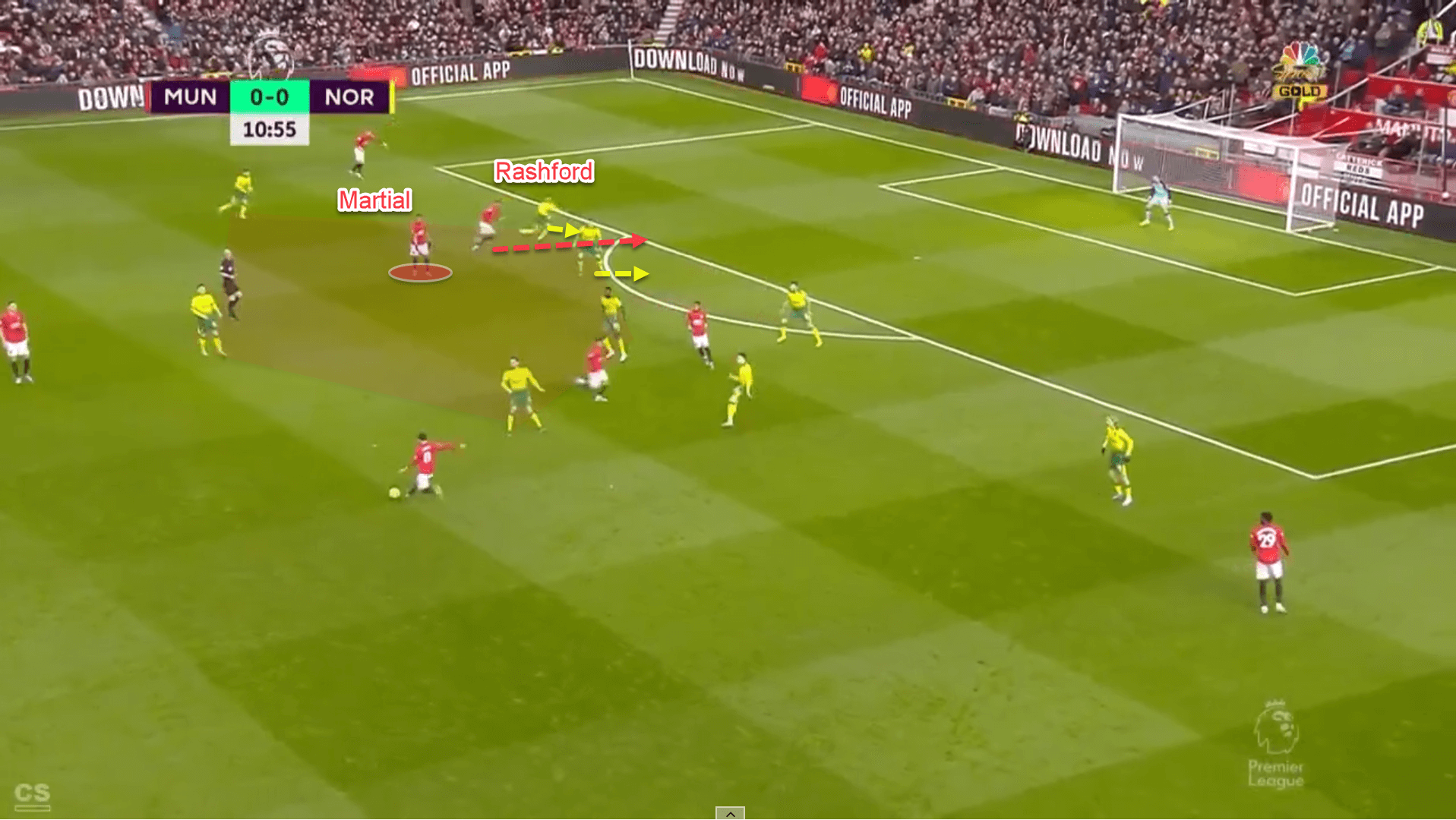
A clear example of this is in the image above. As Martial drops into a space between the opposition lines, Rashford’s direct run beyond the defence brings the defensive line backwards as they are trying to deal with his run; thus creating a larger space for Martial to receive the ball. Somehow, Juan Mata did not spot the Frenchman in the space but this does not take away the fact that Rashford’s run meant that Martial would have more space to operate in if the ball did come his way.
The two players have clear intentions to help each other play through their movement, whether that be Martial opening up space for Rashford to drive into or Rashford running beyond the defence to help create more space for Martial between the lines.
Conclusion
This tactical analysis has clearly shown that Marcus Rashford and Anthony Martial are a great pair, if Manchester United add Sancho to the mix, they could have one of the best attacks in the Premier League.
Although they still have areas they can strengthen, it is undeniable to say that giving the two players the chance to start in the side together was a great decision by Solskjaer. The analysis has shown that their movement and understanding of each other is great, as well as their ability to link up. This can only improve further in the future and although Manchester United’s squad is not complete, they are in good health up top and on the left with Martial and Rashford.

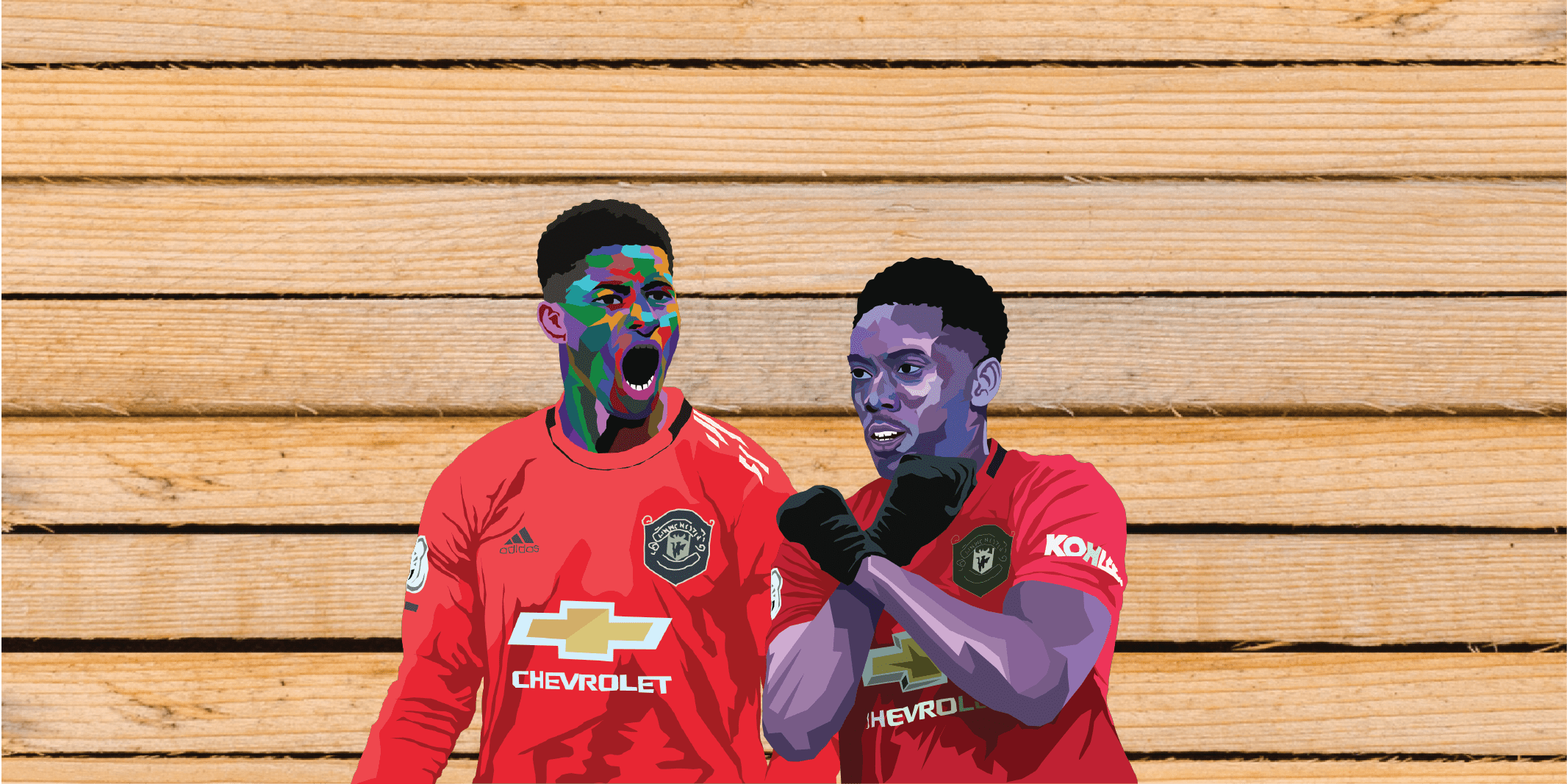



Comments